Indonesische Spiritualiteit

Old or new fake keris
Old or new fake keris, een oude keris of een vervalste nieuwe keris
Old or New keris
Collecting keris has become a very popular hobby, and I see a lot of very good made replica keris, great examples of what the art of keris really is.
In Indonesia people like to see them with an old finish, and unfortunately these keris are sold as old here in Europe. People don’t understand how good and skilled the Empu’s are now, and import from Indonesia is always suspicient. But as long as people love the beautiful made stories about the keris, and love to hear that it is imported from Indonesia,…I’m sorry, but me as Javanese I think that it is fully understandable to give people the story they believe in, even when it is not true… And if people in Europe want a Majapahit keris from the Keraton, then they get a ‘Majapahit keris from the keraton’. It keeps the tradition of the keris alive. It is all about supply and demand...

Looking back in time, i learned a lot about the keris, not only from my family, but maybe even more about some western specialists who did some great research about the keris. There is a big difference in scientific approach between western and eastern people. In the west, the basis of knowledge is trusted objectivity in which: Questioning, analysis and logical thinking are the pillars. In the east there is subjectivity with the following basis: acceptance, observation and experience the things... Western people are very good in arrange things, putting things in different boxes. If you have a book of acupuncture, and the writer is Chinese, you will have to browse threu the book to understand what is written. If you buy a book from a western writer, then you can see that the book is nice arranged in chapters and information is easy to find... Disadvantage is that a western mind have more problems understanding syncretism, following up on conflicting thoughts and oppinnions, and accept if there is no logical explanation in process or event.
Very important are the writings, articles of Mr Grönemann, Mr Dieter Drescher, Mr Tammens and Mr Maisey in understanding the keris. Since 1998, the Indonesians picked up the tradition of the keris after a periode of 50 years in were people with keris were picked up and killed by the government, and my families fled to the Netherlands. Since 2017 Kejawen is even recognised as official religion and people are allowed to put Kejawen as official religion in their passport. The big Javanese community in Suriname and the Netherlands were able to exercise the old traditions like the traditions of the keris.
As an example I googled and immediately saw this keris on the website vikingsword as good example of a new keris with an old finish.

It is very simple to see the difference between a new or and old keris just by following these 5 rules. I worked in the Antique business for many years, and reproducing antique is as old as itself.
In the antique business the origin is very important, and when a new piece of art is being discovered, it is very normal to go back to the origin. The article below proves that all famouse pusaka keris are known by name and what they did. There doesn't suddenly popup a new keris, come on, use your common sence. Like a painting from Picasso, they are all known, and when suddenly an unknown painting popsup, it is absolute fake!
This article show how famous keris like the keris Kiayi Jalak travel from owner to owner and every step is recorded in books.Don't forget that the keris Kiayi Jalak is copied many times and if you
google with keris Kiayi Jalak you will see manny manny copies of the original keris Kiayi Jalak. The original keris is stored in the ridge of a room.

You can clearly see the sharp edges of the blade, the new mendak and grip and the pamor not on the blade.

A Expensive rare pamor and old age
Rare pamor is rare ! and how older the keris is the more preciouse it becomes
B Clear weathering of the iron over the entire blade
Very old looking keris are mostly made old
C Pamor and iron are on the same level
On old keris the pamor seems to be laying on the keris, the blade becomes 3 dimentional
D Wear of the corners is not even acros the blade
The skin of an old keris has aging marks that should be the same all over the keris
E Clear black and white pamor, the iron.
The colour of old keris is different because it was made from locally mined iron ore.
F New dress
In some rare occasions the keris comes without a dress. Most valuable keris have a equivalent dress, mendak and grip.
So I tried to give examples of the 5 golden rules in discovering an old keris or an old made keris.
1 - Keris with rare pamor and very old age
A and F. If I see a keris with a very rare pamor and of very old age the alarm bells starts ringing. First of all, rare pamor is rare !!!! And when it is not stolen also of high value of a family. I am Javanese, we are not stupid to sell a precious piece to some kind of collector ! So, the chance of finding such a keris is also very rare.
About the dress, these keris have a high value, and the owner must have paid a lot of money for such a keris. Out of respect the dress should also have the same appearance. Mostly a mendak of gold and gemstones and a pendok of silver and gold. Not something you would separate from the keris. So, if you see a dealer with mostly old keris in new dress, that doesn’t make sense.

This is a way of how an old keris is kept, with the original dress what was in the hands of my relatives so just as valuable as the keris. The color of the
metal is not that bright black and white as new keris, and the dress, palet wood was more valuable as gold at that time, and the grip of ivory (I turned It around for the picture) are also from high value. The keris in the example has a clear new dress what is always
suspicious.
In the next example you can see the real old keris on top, with the smooth edges, pamor nicle on top of the blade, while the new one has the pamor circles in the blade, because it has been drilled inside the blade and the rough edges. Also the blade looks very rough because of the treatment with acid. And looking at the bright colour of the metal, it looks very new to me. This keris is beeing sold for more then 2000 euro as subscription Majapahit 13th century. Strange the Majapahit started at the very end of the 13th century, but the modern keris is born in the periode around the time of Gajamada, so 14th century...


Real Udan Mas, unwashed.

Pamor is made out of layers, so if you drill through those layers, you will see circles. The pamor Udan Mas is very rare, so an alarm bel starts ringing. Real Udan Mas the circles are forged on the blade. Because of the proces of forging, iron becomes liquid, so those circles could go 'floating' over the blade, A difficult to make pamor. When you drill, the circles will always be excact on the right spot, but the circles are inside of the blade. Because of etching with warangan, arsenic, the iron wears harder than the nickel, causing the nickel to become upside the iron instead of inside the iron. These circles are drilled inside the blade ! So even when this was a old keris, you are actualy paying money for a Udan Mas keris who is actualy a Ngulit Semangka or Beras Wutah. Like some very nice keris who are reshaped with a Naga motive ...
On the lower keris, you can see a rough wear of the iron. The circles are drilled in the blade. The line between the ganja and blade is sharper then the all over sharpness of the edges.
2 – Keris blade looks very old and weathered of age
Old keris are seen as holy and handled as holy. When a keris is very weathered it mostly comes out of an acid bath or out of a river. In the last case you can ask yourself why the keris has been thrown away and if that is the keris you want.
A real old keris has more of a smooth surface and only when the picture is enlarged you see weathering from different kind and size, and not those typical same
size round holes coming from an acid bath.
On top is an old Kujang, being in the ground for centuries and comming from an excavation. You find lots of these items in the ground in Java. In nature, the ground is not always acid. In nature sometimes the Ph is high, and sometimes the Ph is low. So the wear is not even all over the blade. The blade on the bottom is treated with acid and gives those typical holes in metal what you get when putting it in a bath with acid.


Even in closeup, the real old blade is less 'old' than the new blade.

Real old weathering gives a different pattern because not all acid is the same around the blade. This one comes from an excavation and is from the Buddha time
so +-800 A.D. and was in the ground for centuries. When you put it in an acid bath, the grade of acidity is the same all around the blade, so the weathering is the same all over the blade. The
colour of the metal is the exact colour of the old iron. Old pieces like this always have a square pesi.
An other example but then compaired with a new traditional made keris who is not treated to look old, the way it should be!
The top keris is a good example of a new traditionally made keris by Empu Basuki. He still makes traditional keris !
The 2nd picture you see the new keris but then made to look old.


The next blade if from the Tanguh Segaluh, so 700 years old.


Because of the high value of the keris pusaka the blade has been handled with care. You see that this blade looks les weathered as most old made new keris.
Even in a close up you don't see those typical round circles of acid but an uneven natural way of aging

Notice how beautiful after years and years of washing the pamor is on top of the iron !
3 – Pamor and Iron are on the same level ; the pamor is not on the blade
On new keris the level of the iron and nickel is on the same level. Problem with washing with warangan is that the iron becomes black pamor and that change is not reversible ! So, the iron wear of, and the nickel doesn’t react on the warangan and stays on top.
The next example is of an old Majapahit blade, 1500 so 500 years old.

Look how smooth the iron is because of very skillful washing ! And the pamor is beautifully on top of the black iron.
The next example I turned the blade a bit to show how the pamor is on the iron, making the blade more 3 dimensional.

4 – The wear of the iron is not even across the blade
Because of age the edges of the iron are less sharp. But more important the edges should have the same kind of wear all around the blade. I always compare all the edges with a magnifying glass. Look how the nickel is on top of the blade…

Falsifications are always having sanding marks, which should have been faded with time.

You can also clearly see that the pamor and the iron are on the same level and the nickel is not on top of the keris blade
5 – Clear black and white pamor, new iron instead of old iron made of iron ore and meteorite
Old keris are made from old iron, local iron ore, what is not as pure as iron what is produced at the factories now a days. And the nickel in meteorite is only a percentage compared to the nickel from Krupp imported by Groneman in the beginning of the 19 hundred to promote the keris and support the Empu’s who were almost extinct.

The peace of meteorite in the keraton of Surakarta. Metal meteorite only contain 5 to 10% of nickel
The keris below show the iron and nickel on an old keris. The color is not so bright, and the nickel starts to be up the blade.
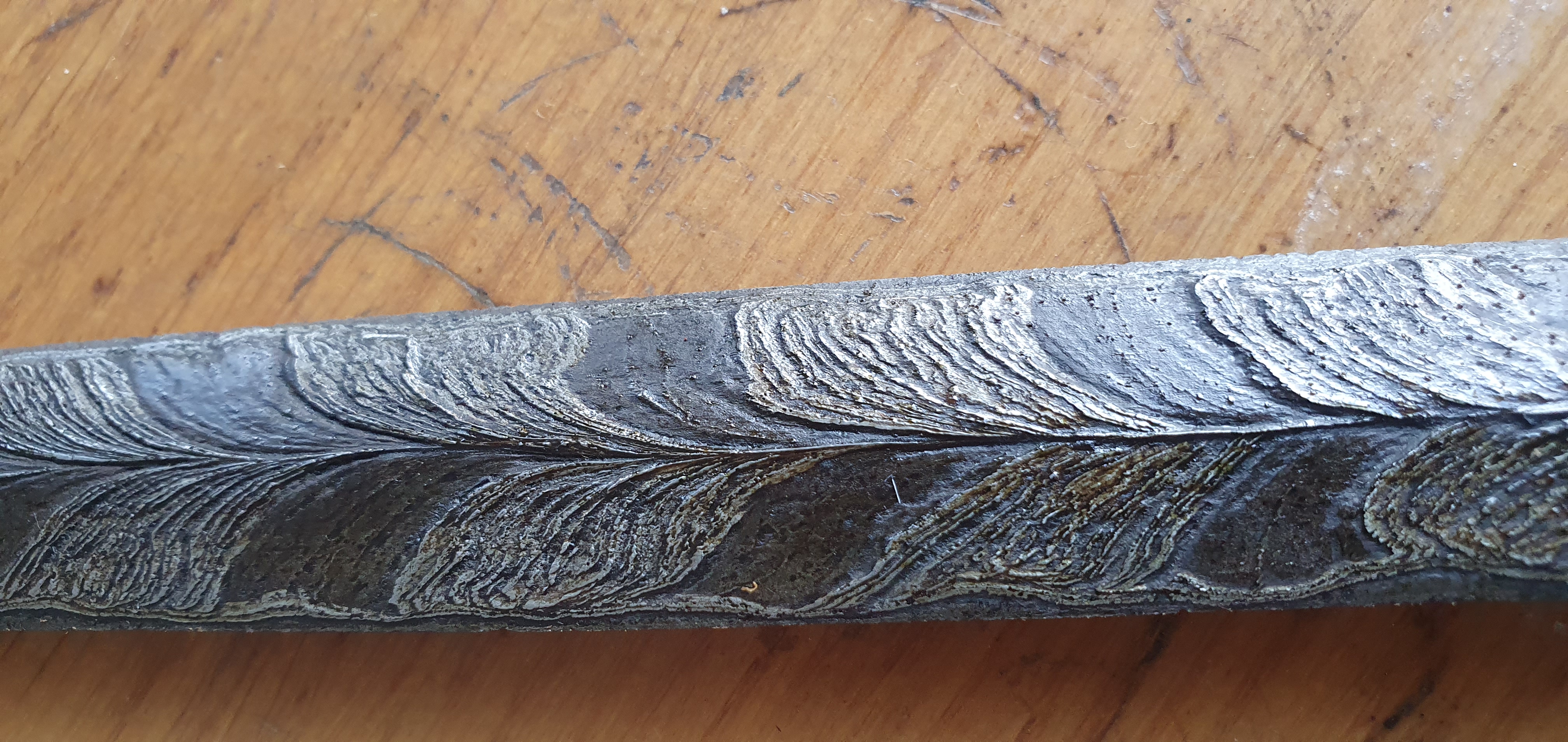
Nice example of an old keris +-200 years, made of old iron what is not as black as the modern made iron. The nickel pamor is nice on top of the keris ; and the nickel looks more metal-isch as the modern pure nickle.
Rongenduru is probably the most wanted pamor pattern. So, this is also one the most copied pamor pattern. Like Lar Gangsir, Ganggeng Kanyut, Udan Mas etc.
don´t be naive, those pamor are rare, so hard to get. The blade below is a nice example of a nice old keris with pamor Lar Gangsir, 600 years old. The pamor is nice on the blade,

On those old complicated pamor blades, also the ganja contain pamor. Here in close up you can see how nice the pamor is on top of the wilah.

Look how this old blade look and how the pamor is on top of the blade

Another nice example of an old blade, look at the irregular wear of the blade without sanding marks.
The next example is perfect to see the 5 golden rules. 1, Rare pamor and new mendak and grip.2, the blade is to heavily looking old. 3, Nickle is not on top of the keris. 4, The edge of the ganja is to sharp. 5, the color of the metal is to black and white what can be created when you have 100% pure iron and nickel.
A real old keris like this doesn’t have such a cheap mendak.
Nice example of how old keris are dressed with mendak and selut.
And here an article on how real kraton keris look like. And yes, the you could buy keraton keris in the palace, but these keris were with gold and diamonds etc. and not cheap at all. They speak about a keris from the keraton what is not expencise for 10.000 guilders, so 4500 euro. Don't get me wrong, the keraton also had a depot full of regular keris, keris they got threu the years, and the most holy keris are just like the holy grale, they look simple. But if you speak about the real keraton keris, then it is all gold and diamonds that is blinking..
I already explained in a previous article that there are 3 types of keris. At the left, the keris Tempur, the fighting keris. Then the costume keris, the keris Ageman. And at the right the keris Tayuhan, the holy keris.

The keris Tempur is made out of hard steel and is mostly black in color. The keris Ageman is made out of pamor metal, so have a clear pamor. Not as clear as the modern keris, and also in the old days the washing with warangan was not so deep black as is the trend now a days. I don’t follow trends, I am myself !
Most of the books only describe the keris Ageman, the keris you carry with you, so must have the external characteristics of where you come from, where you belong to, what your status is etc. Because these keris are being worn, the dress has always signs of being used. These are not the keris you safe in a box on a high place in the house. Knowledge of the keris Tayuhan are esoteric, so always handed over mostly from parent to kid…
The keris Tayuhan, he is made out of holy iron and not out of pamor iron and nickel. The metals used could be iron, steel, but also aluminum and besi kuning. Those keris have a gray-isch look and should not be washed deeply because these keris are not made to have a clear pamor but do have a spiritual meaning., and now comes the lack of knowledge of most washers ! They keep going on until the contrast is better, damaging the blade with ‘scarfs’ and not the old smooth surface of the keris.. Tayuhan keris should not be washed dark !!!!!!! And it is the costumer who wants it , monkey see, monkey do…

And even when the Empu didn’t use iron and nickel to create a Tayuhan keris, you can see that there is still a beautiful aging of the blade.

This is a beautiful example of a keris that has been in a dress for over 70 years. This is an old Palembang blade. This is how an untouched blade looks like, without all those strange holes and strange damages on the blade.
The two keris below came back in the family after 70 years. Although the upper blade is not the oldest you can see that the pamor is already on top of the blade . And of course, the real old keris have the original dress.
And oh yes, when a commercial seller of the keris tells you that it is normal in Indonesia to change the dress to a new one, duh, yes, sure… Most pusaka keris still have the original dress…



This is how old blades look like when they have not been touched for 70 years. No deep deprivation of the blade, old mendak and grip.
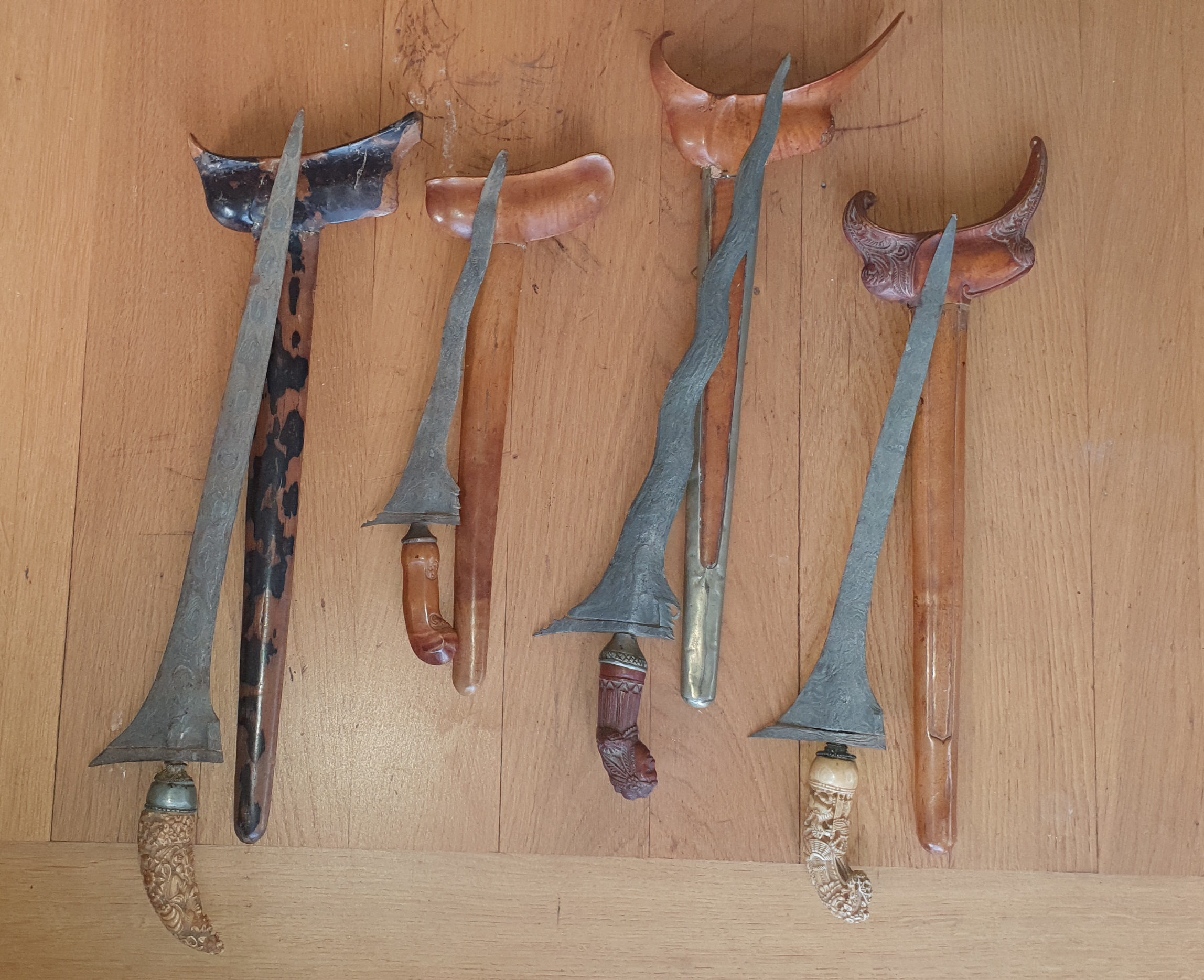
Old keris have an old dress and are dressed according to their status. Except for the keris Tayuhan.
Also some family keris, came to me after being untouched for 70 years. Complete with dress what has marks of being worn, and blades that look pretty good for
such an old blades.
Again a good example of how old keris look..
And there is no different in looks of an old Javanese keris or an old Sumatran keris. This is how old keris look like when they are found somewhere in an old box..

And although the blade is dammaged, all original parts of the sarung and mendak are still there.
The next blade comes from my mothers family, bend pesi, damaged mendak but all is there and you can still see the pamor beiing un top of the blade.

As a Javanese, can you blame people to create exactly what the collectors want ? I think no. The collectors create a market of replica antique keris. As long as the collector’s world stays ignorant and want a keris with a beautiful story, those keris will be make very skillfully. Only when the demand stops, those keris will not be made. Like the beginning of 1900, when there were almost no Empu’s anymore because people didn’t order keris no more.
It was Groneman who stated promoting to collect keris, and many replicas were made in the period between 1900 and 1940. Replica’s sometimes of very famous Majapahit keris, also already antique, but with a flawless dress, because they have never been worn.

Thanks to Groneman, the art of creating a keris is not lost, and he started to stimulate Dutch collectors to start collecting the Keris. The last Empu's
ware doing other smith work like making fences because the Keris was only used and ordered by the Javanese Priayi, the nobles. So Groneman brought the art of the Keris to Holland and these keris,
realy the most beautiful piaces, were sols in Holland. He also imported 100% nickel from Krup stahl to Indonesia to get that beautiful clear pamor. These keris were traditionaly made, but with out
an Isi, and i have seen some, hold them in my hand, they are real time capsules. You can see that they were never used, almost untouched pendok and of the highes finish you can imagine like gold
silver and diamonds... but actualy also replica's! The following article from Indonesia from that periode simlpy says that the keris made from nicle, so end 19th cetury contain, with a clear and
bright pamor, have NO isi.
A last example gives a very clear prove of how an old keris should look.
The oldest know keris is the keris of Knaud, 1342 AD! from Paku Alam who gave the keris to Dokter Knaud because he saved the life of his son. This keris is in the Tropenmuseum in Amsterdam, donated by the family Knaud.
During WW2 the family Knaud buried the keris in the ground, and after years dug it up and took it with them to Holland after the war. The first keris is a keris for sale for 8000 euro, but clearly fake with those typical acid 'wounds' on the blade and even older then the keris of Knaud. On the right, this is how a blade looks when it was buried for almost 8 years.

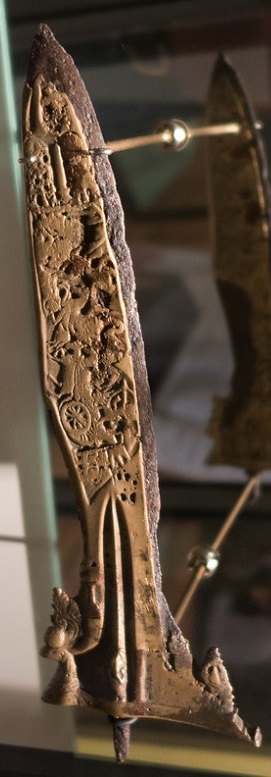
Interesting to know is that the Dutch made pictures of the keris a 100 years ago, and this is how a keris looks when he is 650 years old!

As a Javanese, can you blame people to create exactly what the collectors want? I think no. The collectors create a market of replica antique keris. As
long as the collector’s world stays ignorant and want a keris with a beautiful story, those keris will be make very skilfully. Only when the demand stops, those keris will not be made. Like the
beginning of 1900, when there were almost no Empu’s anymore because people didn’t order keris any more. It was Groneman who stated promoting to collect keris, and many replicas were made in the
period between 1900 and 1940. Replica’s sometimes of very famous Majapahit keris, also already antique, but with a flawless dress, never been worn.
The next photo is from an old newspaper sated 12-6-13-1936 were you can see how old keris look like. Interesting detail, what we call Keris Boeddha now
was called Hindu keris at that time. These are the pusaka from the old Pagerujung kingdom.
At this moment i see a lot of Bali keris from recent date sold as antique, and the Balinese keris smith can create keris that are excact copies of the old keris, they are realy good. Lots of bling bling is asked, so lots of bling bling is made. Realy popular in the old times was the Buta Nawasari grip and Bonaspati on the sarung.
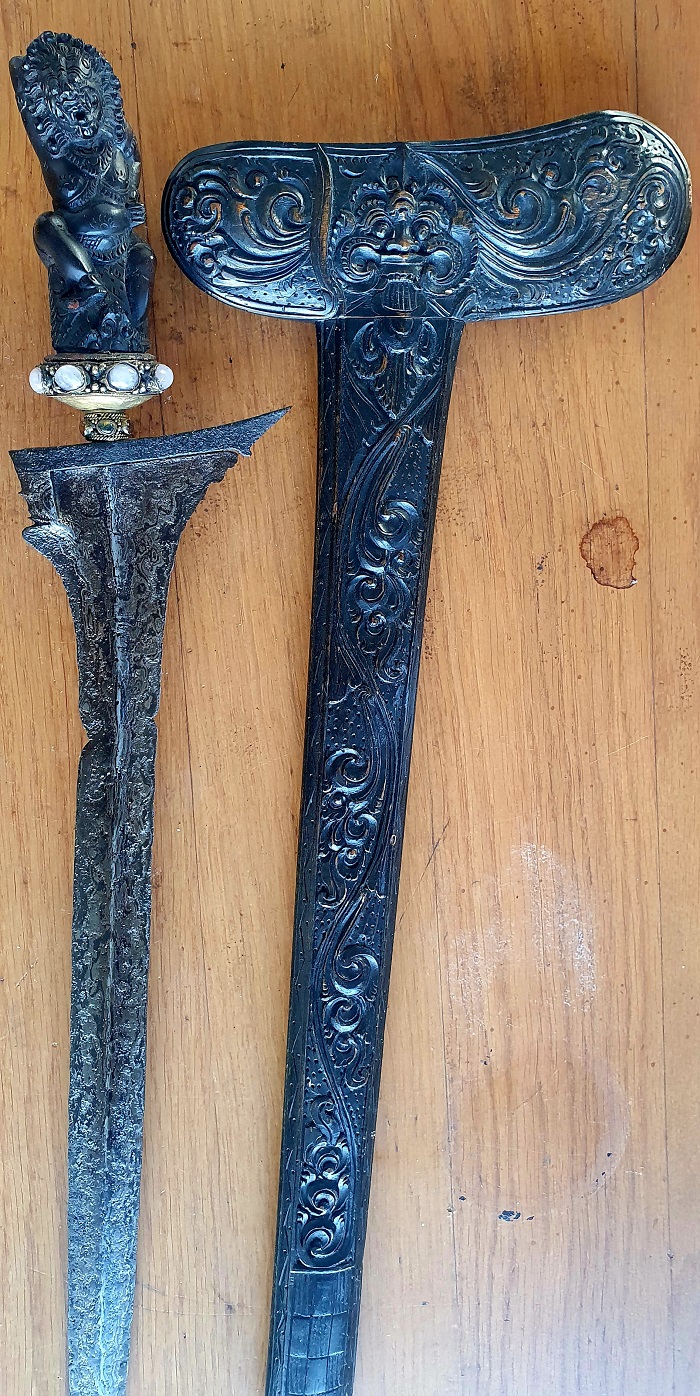
Real old Balinese keris have the same looks as Javanese keris when getting old, and again the pamor is on the blade. The grip is very nicely carved, deep 3 dimentional and not flat, and the mendak and selut are from gemstones and silver.
Now this is probably the most copied Balinese keris and let me put the falsification next to the real old one.
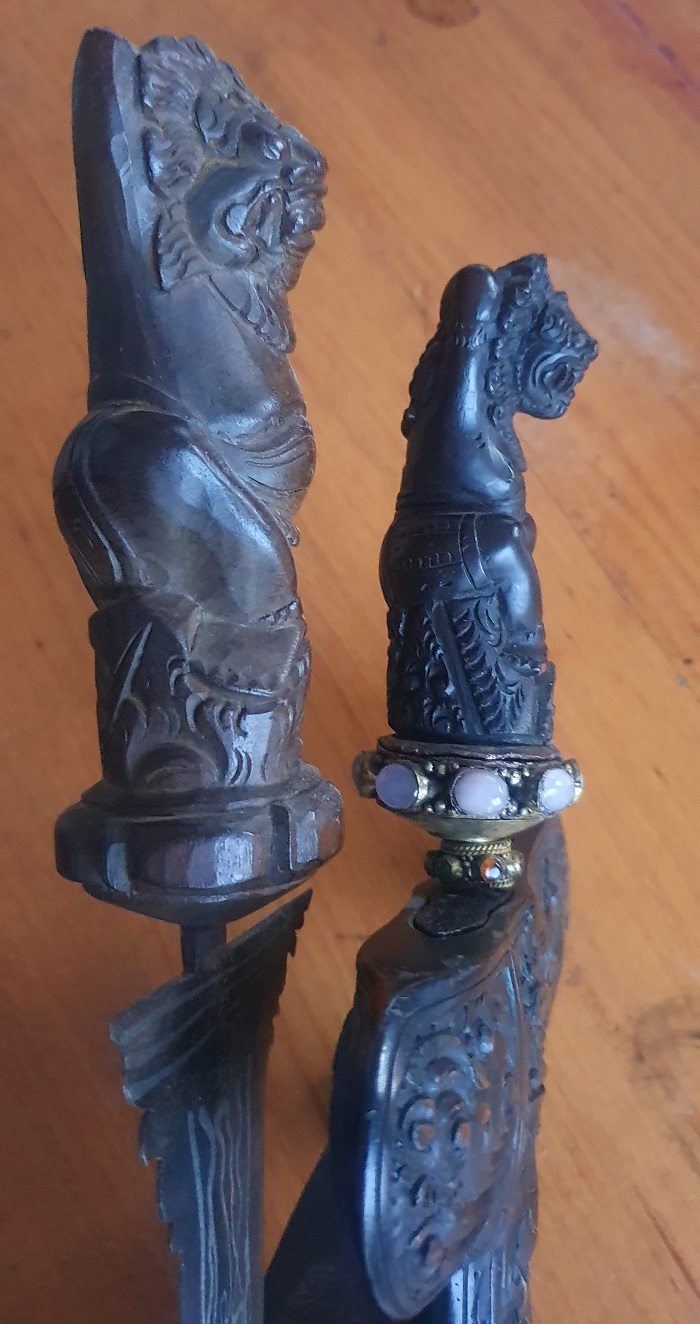
The fake old one looks a bit clunky, misses rifinement, does not have the beautiful details, is not nicely finished and is flatter than the original old work of art. So some ignorant people say, yes but they put time in it. Treu, time to make a copie of a real one... And let us not talk about the fake blade made out of cheap can. It is simply cut out of a flat bigger plate of iron and not forged, and the pamor is etched on the blade, chemicaly painted, and has no layers as on a real keris. 100% fake period.
I don't want to wakeup anyone out of their dream, but at the moment many keris are being forged in the Madurese village of Aeng Tong-Tong. This is not the work of a single Empu, but of several
ironsmiths,
the whole village is invollved.

It's usually traders who buy them by the dozen there and have them aged for trading! The blades of such ironsmiths cost around 20 euros each. Real pusaka's cost around 2500 euros.

Typical keri from Aeng Tong-tong with the cheap mendak and the pendok made out of bling bling cheap punched tin.
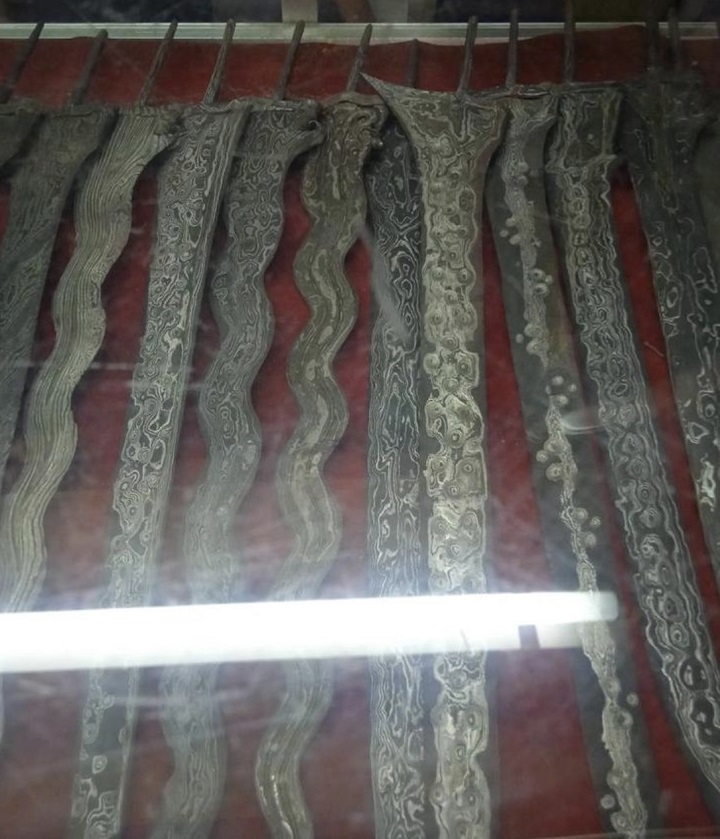
You can buy any Tanguh, dapur and pamor, and if you like ‘old’!
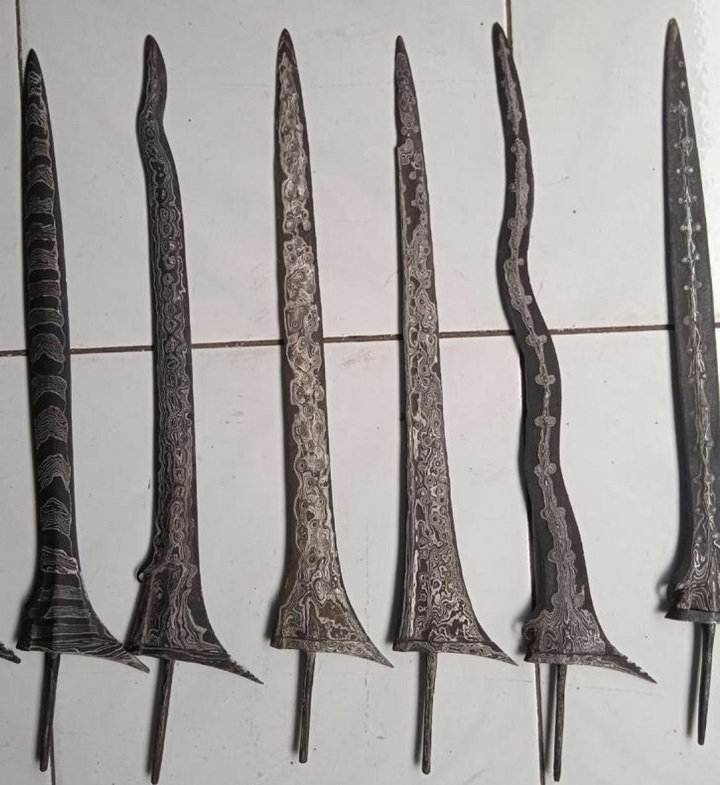
This upper picture comes from a honest dealer asking fair prices!
The village of Aeng Tong-Tong, the village of the keris.... and oh yes, a Balinese keris is also not made bij an Empu. The Balinese keris are also not made with an Isi, but beeing blessed by a priest afterwards. So some people can load an object...

But not only a priest can load an object. By proper meditation and hard work you can make a energy cumming from your center.
The most famous Javanese energy worker is John Chan, many video's are made of his skills...

There is only one big difference. An Isi made by the Empu is there for ever, if you treat the keris correct, and an energy put in the keris or any other object, later on, will fade away. That is
why Balinese keris need to be loaded over and over. But also the keris with Isi the energy can go if you don't treat the keris correct. You have to treat the blade correctly by giving the blade
offerings and only a keris Tayuhan is loaded. Most keris are keris Ageman, the costume keris. They are made spiritual but are not always made with a Isi. Only 1% or 2% are keris Ageman. You keep
them on a high place in the house, closed to keep the energy alive and you actualy do not show those keris...
As already said, almost all books are writen about the keris Ageman, knowledge about the keris Tayuhan belongs to the Isotheric part of the keris, it is handed over from generation to
generation.
Talking about the Isi of the keris, some dealers say that their keris ar a sleep. I am very sorry, but if you don't treat a keris correct, doesn't give the
keris energy by offering, the spirit of the keris leaves the keris. Indeed the best keris are in sleep and some of the most famouse keris pusaka sleep for years and years and suddenly wake up. So
it is nore likely that you don't experience something with a keris and only when needed the keris awakes and does his work.
The next article is about the famouse keris Kiayi Purboniat, also a keris with a legendary history and mostly a sleep, only when neede this real keris comes alive. This is how a real keris pusaka works...
Below is the last part copied from an other page
Some beautiful pictures of old keris from begin 20th century. Most old keris are still complete with mendak and check the old way of washing the keris. A real pusaka is never wached in deep black and white, because the Empu didn't ment the colour to be deep black and white. The replica's made for collectors have that beautiful pamor made from pure iron and pure nickle imported at that time by Krupp Stahl in Austria.
So just a little test, what do you think, Old or Tanguh Kamardikan?

A New mendak, B sharp edges on the metal C Rough blade with acid holes, what do you think?????